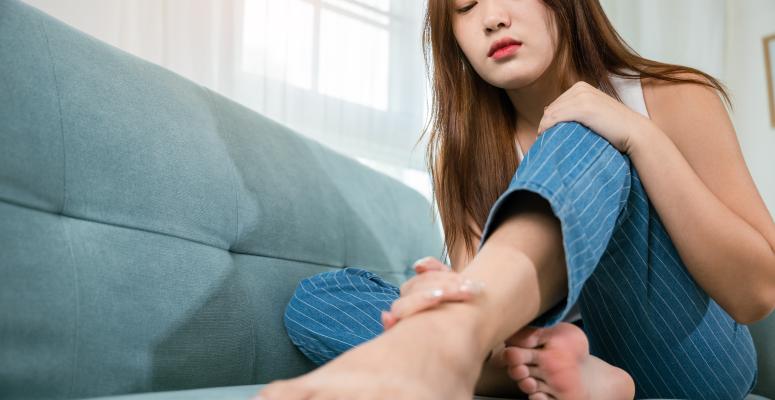
We’ve all probably had a bruise or cut on our feet that we don’t remember the cause of, but they're rarely a reason for concern or medical treatment. And while those will often heal in just a few days, things like protrusions from the foot might need more explanation, especially when it comes to figuring out the best ways to treat them.
A hard protrusion that grows on the top of your foot, known as a bone spur, may seem concerning at first, but there are ways to treat any painful symptoms that stem from it.
Read on to learn about the ins and outs of bone spurs, how they can affect the top of your foot and potential treatment options that can alleviate potential symptoms.
The basics of bone spurs
An osteophyte, more commonly referred to as a bone spur, is a bony protruding growth that can develop on the edge of a bone. An osteophyte can form in your joints between bones due to joint damage, which is why they are especially common in people with osteoarthritis. A bone spur often means that your body is trying to compensate for a loss of cartilage, or it can be trying to heal itself after sustaining an injury that affects your joints.
Bone spurs can occur in many areas of the body, including:
- Hands.
- Wrists.
- Neck.
- Shoulder.
- Lower back.
- Knee.
- Hip.
- Feet.
How bone spurs can affect the top of your foot
While osteoarthritis is the main cause of bone spurs, regardless of where they form, there are a few other reasons why you may develop a bone spur on the top of your foot.
Possible causes for bone spurs on the top of the foot include:
- Injury due to trauma or sports.
- Overuse.
- Obesity or being overweight.
- Flat feet.
- Tight shoes.
Every part of the body that can develop bone spurs will have different symptoms that stem from the growth, though many bone spurs don’t have any symptoms at all.
Potential symptoms of bone spurs on the top of the foot include:
- Pain.
- Soreness.
- Swelling.
- Redness.
- Stiffness.
- Reduced joint mobility.
- Corns.
- Difficulty standing or walking.
5 treatment options for bone spurs on the top of your foot
Even though many foot conditions can heal with time, bone spurs won’t go away on their own, and the bony growths can only be removed by a medical professional through surgery. But if you’re experiencing pain and reduced mobility from a bone spur on the top of your foot, there are quite a few non-surgical treatment options that can help.
Five potential treatments for bone spurs on the top of your foot are:
- Changing footwear — If you spend a lot of time on your feet during the day, changing your footwear can help reduce the symptoms of a bone spur on top of your foot that may interfere with your ability to stand or walk. You should choose properly fitted shoes that have room in the toe area, as well as find orthopedic inserts for an extra cushion if you have a low arch or flat feet.
- Medication — If you need an easy and effective way to alleviate your bone spur pain, then medication might be the treatment option that you’re looking for. Be sure to ask your doctor about taking over-the-counter pain relievers such as ibuprofen or naproxen to provide temporary relief.
- Injection — If you’re experiencing persistent or worsening pain and inflammation from the bone spur on top of your foot, then your doctor may suggest a steroid injection. A cortisone injection is administered directly into the bony growth to help alleviate the pain as well as potential swelling and stiffness.
- Heat and ice therapy — Both heating compresses and ice packs are tried-and-true methods for pain relief, which is why it's often recommended that you alternate between the two. If your bone spur is causing stiffness and pain, apply ice for 15-20 minute intervals to numb the area before using heat to decrease the stiffness for the same amount of time.
- Exercises — A physical therapist will walk you through stretching and strengthening exercises that can help alleviate the pain that stems from bone spurs. They can show you stretching exercises that can increase the foot’s mobility and ease the pressure that the spur may be applying to the surrounding soft tissue. The therapist will also walk you through strengthening exercises that will improve your ankle joint which may be affected by the bone spur.
It's important to note that if the bone spur doesn’t cause any symptoms that interfere with your day-to-day responsibilities, then it doesn’t need to be treated at all.
Alliance PTP can connect you with PT for bone spurs on the top of your foot
At Alliance Physical Therapy Partners, we’re proudly bringing together physical therapy practices across the country to help people get the high-quality PT they need.
Want to see a physical therapist in person? We can put you in touch with an Alliance PTP partner that’s close to you and that can help you address bone spurs on the top of your foot, and any of the symptoms that may be stemming from it.
Not keen on in-person PT sessions or not close to an Alliance PTP partner? No worries. We also offer effective and affordable virtual physical therapy through our Agile Virtual Physical Therapy platform.
Come find help for your injury or chronic condition today!
Get Help at a Location Near You
